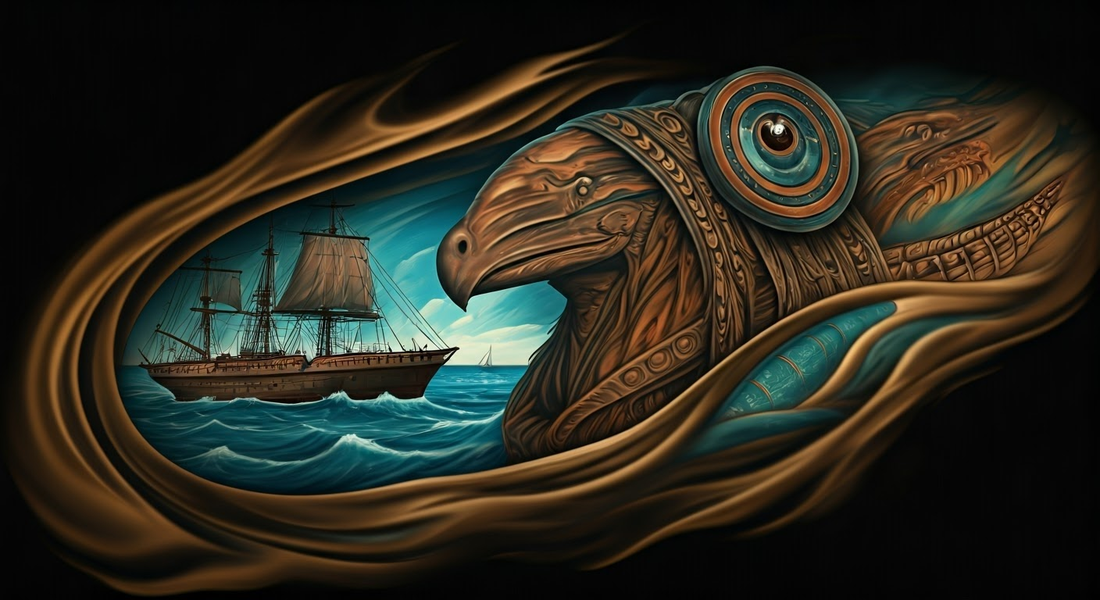
Unveiling the Rich Legacy: History of Tattoos in America
Share

Key Highlights
-
From ancient indigenous rituals to modern artistic expressions, tattoos have left an indelible mark on American culture.
-
European exploration, particularly through figures like Captain James Cook, brought new waves of tattoo traditions to America.
-
Maritime culture played a pivotal role, with sailors embracing tattoos as marks of identity, experience, and superstition.
-
The 20th century witnessed tattoos transitioning from the fringes of society to mainstream acceptance, fueled by biker culture, military influence, and evolving social norms.
-
Today, technological innovations and renowned artists have propelled tattooing into a flourishing art form with a global reach.
Introduction
Tattoos have transitioned from being viewed as unconventional to becoming an integral part of American culture, with cultural significance that reflects their long history. Throughout history, various ancient civilizations adorned their bodies with intricate designs, setting the foundation for contemporary body art practices. Presently, tattoos are widely embraced and celebrated in society.
The evolution of tattoo culture in the United States is a captivating narrative that spans centuries and encompasses diverse traditions. From its humble origins to its current widespread popularity, the journey of tattooing reflects shifts in societal norms and personal expression. Today, tattoos serve as powerful symbols of individuality, creativity, and storytelling.
Exploring the transformation of tattoo culture in America offers insights into the changing perceptions of body art and self-expression. The acceptance and mainstream appreciation of tattoos highlight society's evolving attitudes towards artistry, identity, and personal narratives. Embracing this cultural shift sheds light on the rich tapestry of human experiences woven into each inked masterpiece.
The Origins of Tattooing in America

Long before European settlers came to America, native communities and ancient cultures, including the ancient Greeks, had strong tattoo traditions. These tattoos were not just for show; they carried important meanings. They showed tribal links, social rank, beliefs, and even had healing uses. Proof of ancient Egyptian tattooing was found through mummified remains. This shows that tattooing moved across the world, influencing early tattoo methods in Europe.
When European explorers, like Captain James Cook, arrived in the 18th century, they brought new tattoo practices to the Americas that would eventually influence the western world. Cook's trips to the South Pacific connected him with Polynesian cultures. In these cultures, tattooing was a big part of their rituals and ways of life. This meeting sparked European interest in tattoos. It began a sharing of techniques and styles that would help create tattoo culture in the United States.
Indigenous Traditions and Symbolism
Traditional tattooing held significant cultural and spiritual importance for Native Americans, serving as a powerful medium for conveying messages about one's heritage, tribe, and connection to the natural world. Such tattoos, with their intricate designs, were often created using hand-tapped needles and natural pigments, reflecting a deep-rooted tradition that celebrated pivotal life events such as coming-of-age rituals, battle triumphs, or spiritual transformations.
Unfortunately, with the arrival of European colonists, many of these sacred traditions faced suppression and erasure. Christian missionaries viewed indigenous tattooing practices unfavorably and actively sought to suppress them, leading to the loss or concealment of valuable knowledge and skills associated with the human body and Native American tattoo artistry.
In recent times, there has been a resurgence of interest among Inuit women in reviving these ancient tattooing traditions among Indigenous communities. Dedicated Indigenous tattoo artists are spearheading efforts to reclaim and preserve their ancestral practices. By imparting knowledge, educating others, and actively engaging in traditional tattooing techniques, these artists are ensuring the continuity and revitalization of their cultural heritage through this enduring art form.
European Influence in the Early Days
Captain James Cook's trips to the Pacific islands introduced him to Polynesian cultures that featured detailed and important tattoos. He wrote about these practices in his journals and showed them in his drawings. This caught the attention of people in Europe, sparking a keen interest in this unique art form. Encouraged by these experiences, European sailors began to get tattoos while traveling. They returned home with stories about these people and their meaning.
This rising interest happened around the same time as permanent European settlements began in America. Sailors shared their new tattoo patterns and practices, which helped bring tattooing to America. What started as a curiosity among sailors slowly spread to port cities, and this created a special American tattoo culture.
The early American tattoo designs often had European roots, featuring maritime themes, religious symbols, and patriotic images. As the country grew, so did its tattoo art, mixing in influences from different cultures and showing the energy of a society that was changing quickly.
The Sailors' Marks: Tattooing in Maritime Culture

The vast oceans have always been very attractive. For sailors who took risks in these unknown waters, tattoos were more than just body art. In the close communities of the United States Navy and other groups, nautical tattoos turned into a special way to tell stories. These tattoos showed experiences of adventure, strength, and the real dangers of life at sea, while rarely being adopted by members of the general public.
Famous names like Norman "Sailor Jerry" Collins will always be remembered in tattoo history. Sailor Jerry, a Navy veteran, learned his skills while traveling. He created a famous tattoo shop in Honolulu. He became well-known for his bold designs that were inspired by the sea and Japanese tattoo styles.
Significance of Nautical Tattoos
In the golden age of sail, ships moved by wind and human effort. Sailors took dangerous trips across rough seas. Each tattoo became a strong symbol of bravery and experience. Many tattoos were also based on superstitions meant to keep bad luck away. When sailors crossed Cape Horn, the southern tip of South America, they could earn a special tattoo. This showed their strength and ability to survive tough conditions.
Sailors decorated their arms with anchors. These symbols stood for steady hope and showed their desire to return to land and find safety. Swallows also appeared in many tattoos. These birds, known for long travel, were thought to lead lost sailors back home and served as a charm for safe trips across the oceans.
These tattoo marks went beyond simple art. They united sailors' experiences, beliefs, and friendships into a unique maritime tradition.
The Spread of Tattoo Culture through Ports
As ships arrived from faraway places, they brought unique products and the lasting art of tattooing. Busy port cities, full of sailors looking for rest and fun, allowed tattoo shops to grow. New York City became a key place for American tattooing. It attracted artists and clients from different backgrounds.
The Bowery, a neighborhood in Lower Manhattan, became famous for having many tattoo shops. Skilled artists, many taught at sea, set up their work here. These early tattoo shops greatly influenced the history of tattooing in the United States. They became:
-
Places for creativity, mixing different styles and techniques.
-
Social spots for sailors, artists, and anyone wanting to decorate their skin with lasting designs.
-
Venues where sea stories blended with city styles, helping create a special American tattoo look.
The 20th Century: Tattoos from the Margins to Mainstream
The 20th century brought major changes in society and culture. With these changes, the way people viewed tattoos started to change too, though not quickly. Tattoos still had some stigma attached to them, but over time, they began to come out of the shadows. Subcultures and groups that went against mainstream ideas started to embrace tattoos.
By the later part of the century, what was once considered unacceptable was slowly becoming normal. Tattoos, which were mainly linked to sailors, bikers, and those on the outskirts of society, began to be seen as a common way to express oneself. For many, tattoos also became a bold fashion statement.
The Biker and Military Influence
The years of the Second World War greatly increased the presence of tattoos, including the trend of getting a first tattoo, in American culture. Soldiers who were stationed worldwide looked for tattoos to remember their service, often focusing on the subject matter of their experiences. They saw these tattoos as signs of friendship and protection during the chaos of war. This trend of military tattoos linked body art with bravery and the shared experiences of facing serious situations.
At the same time, motorcycle clubs in post-war America brought tattoo culture into the public eye. Many bikers were veterans who wanted a sense of community. They adopted tattoos as strong symbols of rebellion, independence, and brotherhood. Their bold designs often included skulls, eagles, and club symbols. These tattoos showed solidarity and pushed back against societal norms.
The mix of military experience and the rise of biker culture pushed tattoos into mainstream culture. It challenged long-standing negative views. Still, it would take many more years for tattoos to completely lose their rebellious image and be accepted by society as a whole.
The Role of Tattoo Studios in Popularizing the Art
As tattoos become more accepted in society, tattoo studios have helped change how people view this art. These shops are no longer just found in the back alleys of port cities. They have grown into real businesses that attract new artists who want to push their creative limits.
These artists use better tools and techniques to make tattooing a skillful craft. They try out many different styles. This includes traditional designs from America and Japan, as well as photorealism and abstract art. This shows how versatile and creative body art can be.
Tattoo conventions have also helped this change. These events allow artists to show their work, exchange ideas, and learn from each other. The tattoo shop has changed from a secret meeting place into a space for artistic expression. It now draws a wide range of clients who want to decorate their bodies with meaningful and eye-catching designs.
The Modern Renaissance of Tattoos
The 21st century has seen a huge change in tattoos. Technology has improved, social norms have shifted, and many celebrity tattoo artists are popular now. Because of this, body art has moved from a small niche to a common way for people to express themselves.
Modern tattoos come in many styles. They can be detailed mandalas, soft watercolor designs, realistic portraits, or bold geometric shapes. Tattoos are now more visible in popular culture. Social media and endorsements from celebrities have made them more accepted. This has helped erase old stereotypes and turned tattooing into a thriving global art form.
Technological Advances in Tattooing
The art of tattooing has deep roots in ancient traditions. However, today, it has changed a lot due to new technology. In the late 1800s, the electric tattoo machine, which replaced older methods that often used a wooden handle, was invented. This new tool replaced the older hand-tapped methods and made the tattooing process more precise and efficient.
Interestingly, this modern tattoo machine links back to Thomas Edison. In 1876, Edison created an electric pen for etching. A tattoo artist named Samuel O'Reilly adapted Edison's design to make the first electric tattoo machine. This helped tattoo artists work faster and with more accuracy, which opened up new possibilities for tattoo art.
Now, tattoo machines keep getting better. Artists use advanced equipment and sterilized needles. They also have many high-quality inks to choose from. These improvements lead to safer practices and allow artists to create detailed designs that last.
The Rise of Celebrity Tattoo Artists
As tattoos became more popular, a new kind of celebrity tattoo artists started to shine. They amazed people with their amazing skills and lively personalities. Shows like "Miami Ink," which take place in Miami's lively tattoo scene, helped talented artists get noticed. These shows highlight the art and excitement that happen in tattoo shops.
Cities such as Los Angeles are famous for body art and entertainment. They became popular spots for well-known tattoo artists. From Kat Von D's High Voltage Tattoo to Dr. Woo's simple yet beautiful designs, these artists built large fan bases. Their waiting lists could last for months or even years.
Social media also played a huge role in helping these celebrity tattoo artists reach more people. Instagram, especially, turned into a place where artists display their work, meet clients, and create global tattoo trends. This rise of talented tattoo artists has improved the view of tattooing and inspired many new artists to be more creative and skilled with their art.
Conclusion
Tattoos in America have a rich and diverse history, blending traditions from native groups, European influences, maritime culture, and societal changes. Originally used as symbols of identity or rebellion, tribal tattoos have evolved into popular art forms today. Advancements in technology and endorsement from celebrities have propelled tattooing into a new era, where intricate designs and innovative techniques abound.
The transformation of tattoos from ancient times to the modern age reveals a fascinating cultural narrative that is both intriguing and educational. Unraveling the stories behind different art styles and their meanings offers a glimpse into personal and cultural histories that are etched onto skin. Exploring frequently asked questions about tattoos can provide further insights into the significance and evolution of this unique form of body art. Let us celebrate the diversity of narratives and artistic expressions that adorn individuals, reflecting a tapestry of experiences and traditions.
Frequently Asked Questions
What was the significance of tattoos in ancient American cultures?
For indigenous people, tattoos were like a visual language connected to their traditional ways. They could show clan heritage, religious ideas, personal achievements, or even act as a mark of wealth or status in some tribal groups, often placed on specific areas of the body.
How did sailors contribute to the spread of tattoos in America?
Sailors, such as the well-known Sailor Jerry, discovered tattooing during their trips in the South Pacific. They were inspired by the local cultures and returned with tattoo designs and customs. This helped create a strong love for tattoos in the United States Navy and in port cities.
When did tattoos start in the US?
Martin Hildebrandt is widely recognized as the pioneering professional tattoo artist in New York, having established his shop in the 1840s. His work laid the foundation for the tattoo culture that would later flourish in the city and beyond. Interestingly, during the Civil War, there was a notable surge in the number of soldiers opting to get tattoos, thanks in large part to Hildebrandt's influence. These tattoos often held personal significance or served as symbols of camaraderie among military comrades. The wartime era marked a significant period in the history of tattooing, reflecting individuals' desire to express themselves and commemorate important experiences through body art, similar to how Nora Hildebrandt and other tattooed ladies captured public fascination.
How did Native Americans get tattoos?
Native Americans have a rich history of indigenous tattooing practices that were unique to each tribe. These practices often involved using sharp bone needles and natural colors sourced from the environment. The techniques employed by Native American tribes included tapping the needle into the skin to create intricate designs, following age-old traditions passed down through generations. Each tribe's tattoos held significant cultural and spiritual meanings, serving as symbols of identity, status, and connection to the natural world. Tattoos played a crucial role in storytelling and preserving tribal history, making them an integral part of Native American heritage.
What Is Tattoo Culture in the United States Like Now?
In the 21st century, tattoo culture in the U.S. has experienced a significant resurgence and diversification. What was once considered a symbol of rebellion has now evolved into a mainstream fashion statement embraced by individuals from various backgrounds, contributing to the broader acceptance of tattoos. Notably, for the first time, tattoos have gained popularity among younger women, emerging as one of the fastest-growing demographics embracing diverse tattoo styles.
The evolution of tattoo culture can be attributed to shifting societal perceptions and increased acceptance of body art as a form of self-expression. Tattoos are no longer confined to specific subcultures but have become a widely embraced means of showcasing personal stories, beliefs, and artistic preferences.
Moreover, advancements in tattoo technology and techniques have contributed to the growth of the industry, offering individuals a wide array of design options and customization possibilities. From intricate black and grey designs to vibrant watercolor tattoos, the contemporary tattoo scene caters to diverse tastes and preferences.
As tattoos continue to transcend traditional stereotypes and evolve into symbols of individuality and creativity, they play an integral role in shaping modern fashion trends and self-representation practices. The intersection of artistry, cultural influences, and personal narratives within tattoo culture underscores its enduring appeal and relevance in today's society.
Why did tattoos have negative connotations tied to them for much of the 20th Century?
In the 20th century, tattoos were often stigmatized in Western society, associated mainly with sailors, bikers, and other non-conventional groups. The negative perception stemmed from a lack of understanding of the diverse cultural meanings behind tattoos, hindering widespread acceptance. However, over time, perceptions have shifted as people have come to appreciate tattoos as forms of self-expression and art. Today, tattoos are embraced by individuals from various backgrounds and are celebrated for their creativity and personal significance. This shift in attitude reflects a broader acceptance of diversity and individuality in modern society.

